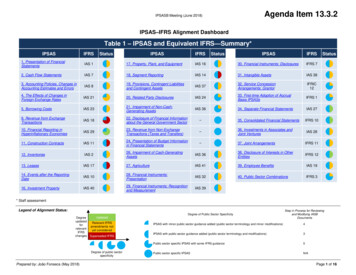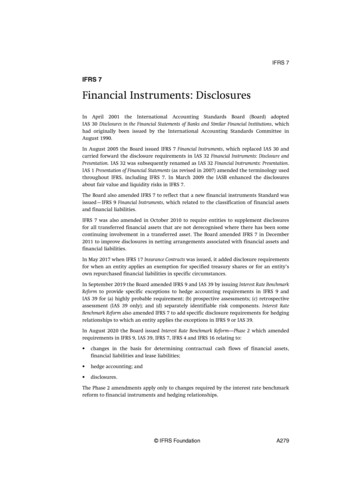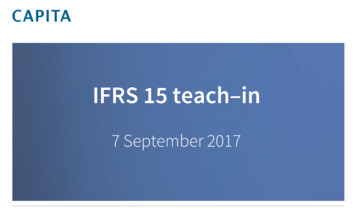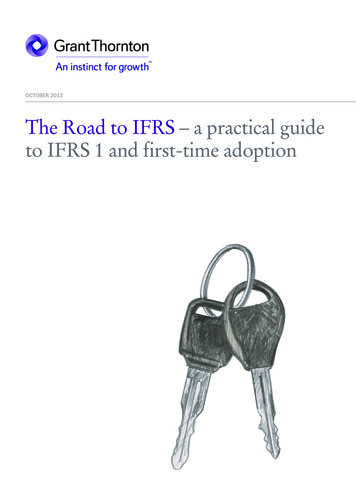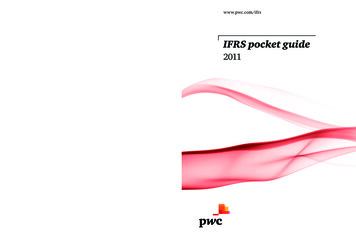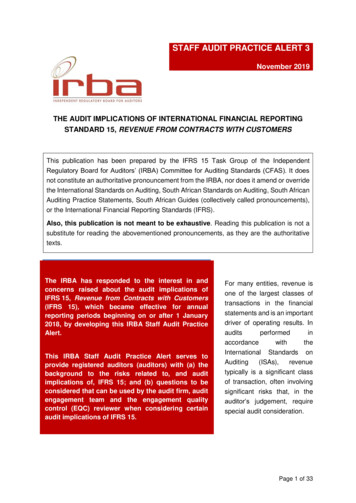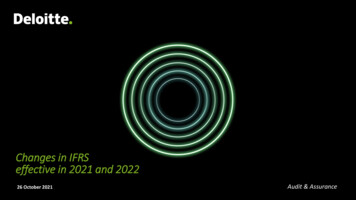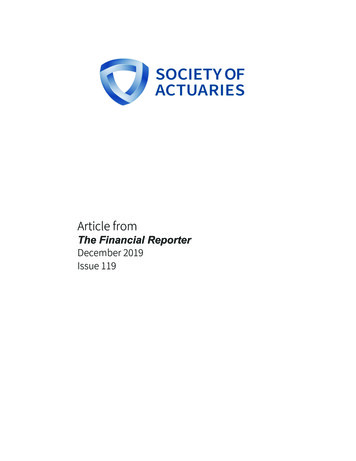
Transcription
Article fromThe Financial ReporterDecember 2019Issue 119
IFRS 17: Implications forOnerous ContractsBy Tze Ping Chng, Steve Cheung, Terrance Lee and Fung ChanAfter a very long journey, the International AccountingStandards Board (IASB) issued IFRS 17. IFRS 17 replacesIFRS 4, which was issued in 2004. The overall objectiveof IFRS 17 is to provide a more useful and consistent accountingmodel for insurance contracts among entities issuing insurancecontracts globally.To increase the transparency of an entity’s performance, the entityis required to group contracts in a way that reflects the profitability at initial recognition. IFRS 17 requires an entity to identifyportfolios of insurance contracts (within the same financial reporting year) and to further divide the group of contracts that areonerous at initial recognition (if any) from the profitable groupof contracts. The IASB determined that the onerous contractsshould not be hidden and that the respective losses should be accounted for explicitly in the statement of comprehensive income(SCI) when it was known. This treatment is consistent with therecognition of losses for onerous contracts in accordance withIFRS 15 Revenue from Contracts with Customers and IAS 37 Provisions, Contingent Liabilities and Contingent Assets.An insurance contract is onerous at the date of initial recognition if the fulfilment cash flows (FCF) allocated to the contract,any previously recognized insurance acquisition cash flows, andany cash flows arising from the contract at the date of initialrecognition in total are a net outflow [IFRS 17.47].1Reinsurance contracts held cannot be onerous [IFRS 17.68]. Instead of profitable or onerous contracts, IFRS 17 views them asthe net cost or gain on purchasing the reinsurance contracts.Both positive and negative contractual service margin (CSM)are allowed for reinsurance contracts held (RCH), unless thereinsurance coverage relates to events that occurred before thepurchase of the reinsurance (retroactive cover). In subsequentmeasurement, changes in the FCF that relate to future serviceare adjusted to RCH’s CSM, unless they are stemming fromchanges that do not adjust the CSM of the related underlyingcontracts (UC).Table 1Summary of Profitable and Onerous Contracts Treatment for UCs and RCHs (updated for the June 2019 proposedamendments by IASB)—Under GMMUC/ RCH and Profitability groupLinkage WithRCHs or UCsProfitable UCWithout RCHcoveredOnerous UC30Initial CSMInitial Recognition in SCILinkage Between UCand RCH in Subsequent MeasurementNon-negativeNo day 1 gain is recognizedN/AZeroRecognize the loss immediatelyProfitable UCWith RCH covered Non-negativeOnerous UCWith nonproportionate RCHcoveredZeroOnerous UCWith Proportionate RCH coveredZeroRCHRelated UCs areprofitable at initial recognitionPositive or negativeNonproportionate RCHRelated UCs areonerous at initialrecognitionProportionate RCHRelated UCs areonerous at initialrecognition DECEMBER 2019 THE FINANCIAL REPORTERNo day 1 gain is recognizedOffset between UC andRCH if the UC becomesRecognize the loss immediately onerous or more onerous(on the portion coveredby RCH)Recognize the loss immediately, and with consideration ofthe RCH income offsetNo day 1 cost or gain is recognized (except for the net costunder retroactive cover)Adjust RCH CSM with Recognize RCH income to offconsiderations of UC set the UC loss (on the portioncovered by RCH)
Under the June 2019 proposed amendments to IFRS 17, for onerous UCs that are covered by RCHs that provide proportionatecoverage, an entity shall adjust, at initial recognition, the CSM ofthe RCH and recognize RCH income to offset the correspondingportion of UC loss. Table 1 summarizes the latest IASB proposalson the treatment of the profitable and onerous contracts for UCsand RCHs under the general measurement model (GMM).This article discusses the key IFRS 17 requirements of the accounting for onerous contracts, with an illustrative example todemonstrate the systematic allocation requirement for the UCs.HOW DOES IFRS 17 APPLY TO ONEROUS CONTRACTS?What is the level of aggregation requirements todetermine the profitability grouping of insurancecontracts issued as of initial recognition?To the extent that paragraph 17 applies, an entity may identifythe group of onerous contracts by measuring a set of contractsrather than individual contracts [IFRS 17.47].An entity should apply the recognition and measurement modelrequirements of IFRS 17 to onerous contract testing. An entity may identify the group of onerous contracts by measuringa set of contracts rather than individual contracts if an entityhas reasonable and supportable information to conclude that aset of contracts will all be in the same group (i.e., there will beno offsetting effects of onerous and profitable contracts in thesame group). If an entity does not have reasonable and supportable information, then it shall determine the group of onerouscontracts by considering individual contracts. While there is noclear guidance on the “reasonable and supportable information,”it is generally expected that the entity can leverage relevant information produced during the product development stage.Can an entity reassess the onerous contract groupingin subsequent measurement?An entity shall establish the groups at initial recognition and addcontracts to the group applying paragraph 28. The entity shallnot reassess the composition of the groups subsequently [IFRS17.24] except when there is modification.Are there any particular differences for onerouscontract treatment under the GMM and variable feeapproach (VFA)?No. The distinctions between GMM and VFA are the same forprofitable and onerous contracts.What is the treatment for a group of contracts under thepremium allocation approach (PAA) that is onerous?The same principle of grouping applies to insurance contractsunder PAA, but the standard wording is adapted to reflect itsspecific characteristics. The entity assumes all contracts are notonerous at initial recognition unless facts and circumstances indicate otherwise. The entity also assesses whether the profitablecontracts at initial recognition have no significant possibility ofbecoming onerous subsequently by assessing the likelihood ofchanges in relevant facts and circumstances.If facts and circumstances indicate that a group of contracts isonerous during the coverage period, an entity shall calculate thedifference between (i) the carrying amount of the liability forremaining coverage (LRC), excluding the loss component determined under PAA, and (ii) the FCF that relate to remainingcoverage similar to what is needed under the GMM. The entityshall recognize this difference as a loss and increase the liabilityfor remaining coverage.What is a systematic allocation between (i) the losscomponent of the liability for remaining coverage and(ii) the liability for remaining coverage, excluding theloss component, under GMM?The entity should track the remaining loss component (LC). Ifa group of contracts is onerous, there is no CSM. The entityshall allocate the subsequent changes in FCF of the LRC on asystematic basis between (i) the LC and (ii) the LRC, excludingthe LC, with the following considerations: estimates of the present value of future cash flows for claimsand expenses released from the LRC because of incurredinsurance service expenses; changes in the risk adjustment (RA) for nonfinancial riskrecognized in profit or loss because of the release from risk;and insurance finance income or expenses.What is the treatment for contracts that become moreor less onerous in subsequent measurement?See Table 2 (pg. 32) for a summary of treatment for contractsthat become more or less onerous in subsequent measurement.DECEMBER 2019 THE FINANCIAL REPORTER 31
IFRS 17: Implications for Onerous ContractsTable 2Summary of Treatments for Contracts That Become More or Less Onerous in Subsequent MeasurementSubsequent Measurement/Measurement ModelGMMVFAImplications to SCIContract becomes onerous ormore onerousUnfavorable changes relating to futureservice in the FCFarising from changes inestimates of future cashflows and RA exceedthe carrying amount ofthe CSMDecrease in the amountof the entity’s share of thefair value of the underlyingitems or increase in FCF relating to future service thatexceed the carrying amountof the CSMAn entity shall recognize an LC (oradditional LC) depicting the losses inSCI to the extent of the excess listed.Subsequently, this LC is then presented in SCI as reversal of losses ononerous groups and is consequentlyexcluded from the determination ofinsurance revenue.Onerous contract with favorable changes related to futureserviceAny subsequentdecreases relating tofuture service in the FCFarising from changes inestimates of future cashflows and RAAny subsequent increasesin the amount of the entity’s share of the fair valueof the underlying items ordecrease in FCF relating tofuture serviceAn entity shall allocate the changessolely to the LC until the LC is reducedto zero and subsequently allocate theremaining portion of changes (if any)to CSM after the LC is depletedTable 3Projected Best Estimate Cash Flows (BECFs) and Initial MeasurementBECFs/YearYr1Yr2Yr3Premium income708090Claims and expense outgo1010250Investment component (included in the 0.513.7IFIE allocated to LRC, excluding LC(1.1)(2.4)(5.3)IFIE allocated to LC(0.3)(0.3)(0.5)(21.5)(2.7)(5.8)Initial MeasurementInitial lossInitial loss ratio207.8%Table 4SCISCI/YearInsurance revenueInsurance service expenseClaims and expenses incurredLosses on new onerous contractsAllocation of subsequent changes in FCF to LC(20.0)Insurance finance income and expenses (IFIE)Total profit32 DECEMBER 2019 THE FINANCIAL REPORTER
ILLUSTRATIVE EXAMPLE FOR SYSTEMATICALLOCATION UNDER THE GMMThe IASB considered whether to require specific methods totrack the LC but concluded that any such methods would beinherently arbitrary. It therefore decided to require an entity tomake a systematic allocation as noted above.A simple three-year endowment product is created to illustrateone possible way of the allocation of subsequent changes in FCFof the LRC on a systematic basis between (i) the LC and (ii) theLRC, excluding the LC.Table 3 summarizes the key fact pattern. We assumed no RA,time value of options and guarantees, and investment income.With the discounting applied, FCF equals 20, which means thatthe expected outflow is larger than the expected inflow; it is anonerous contract with an initial loss of 20. The initial loss ratio iscalculated as the initial loss divided by the present value of totaloutgo (some also suggested the total outgo should exclude theinvestment component, which is not illustrated here).system development to ensure the SCI and corresponding disclosures can be handled properly by the IFRS 17 reporting systems.The illustrative example included in this article provides onlyone of the approaches that fulfill the standard requirements under GMM, and we expect there are other ways of performing thesystematic allocation. Similar to experience with Solvency II, it isgenerally expected that certain market consensus will convergeon the approaches. The related methodology and considerationsshould be properly documented and approved within the entity’s governance structure, and agreed with the entity’s auditor. Itis also important for individual entities to understand both thefinancial and operational impacts of the onerous contracts at thebeginning of the implementation journey.The views reflected in this article are the views of the authors and donot necessarily reflect the views of the global EY organization or itsmember firms.Tze Ping Chng, FSA, MAAA, is a partner at Ernst &Young Advisory Services Limited in Hong Kong (EYHK). He can be contacted at tze-ping.chng@hk.ey.com.Table 4 summarizes the items to be shown in SCI in this simplified example: Insurance revenue equals Insurance component of the outgo *(1- loss ratio) For the insurance service expense, (i) the total outgo,excluding the investment component, is presented assuming everything goes as expected, (ii) the initial loss isrecognized immediately in the SCI, and (iii) the allocationof subsequent changes in FCF to LC equals Insurance component of the outgo * loss ratio.Steve Cheung, FSA, is a director at EY HK. He can becontacted at steve.cheung@hk.ey.com.Terrance Lee, ASA, is a senior associate at EY HK. Hecan be contacted at terrance.lee@hk.ey.com. For the insurance finance income and expenses, (i) IFIE allocated to LC equals PV of total outgot * discount ratet * loss ratio,and (ii) IFIE allocated to LRC excluding LC equals FCFunwinding minus Reversals of losses (IFE). Certain checking needs to be performed for the SCI: (i) Thetotal insurance revenue is the amount of premiums paid tothe entity, adjusted for a financing effect and excluding anyinvestment components; (ii) the total reversal of loss plusthe loss component part of investment component shouldequal the initial loss recognized in SCI; and (iii) total profitshould tie with the net CFs (given no investment income isconsidered in this example).CONCLUSIONWhile onerous contracts may not be a significant part of an entity’s portfolio generally, the entity should consider its logic duringFung Chan, ASA, is a senior associate at EY HK.He can be contacted at fung.chan@hk.ey.com.ENDNOTE1 The references quoted by [ ] represent text or extracts from “IFRS 17 Insurance Contracts incorporating amendments as proposed in Exposure Draft Amendments toIFRS 17” (released as of June 26, 2019, by the International Accounting StandardsBoard) and Basis for Conclusions.DECEMBER 2019 THE FINANCIAL REPORTER 33
recognition of losses for onerous contracts in accordance with IFRS 15 Revenue from Contracts with Customers and IAS 37 Provi-sions, Contingent Liabilities and Contingent Assets. An insurance contract is onerous at the date of initial recogni-tion if the ful lment cash ows (FCF) allocated to the contract,

